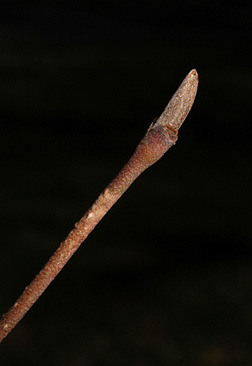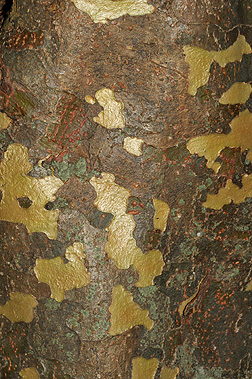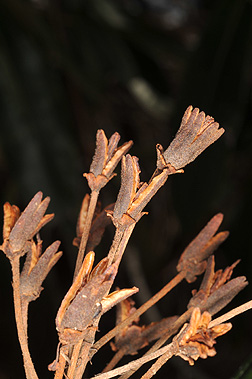VT Dendro Lab Notes
kousa dogwood
Cornaceae
Cornus kousa
Leaf: Opposite, simple, oval to ovate with an entire margin, arcuate venation, 2 1/2 to 4 inches long, 2 to 2 1/2 inches wide, shiny dark green above, paler below with some tufts of golden-brown hair present particularly at base of petiole.
Flower: Species is monoecious; white to slightly yellow-white bracts surround a cluster of small inconspicuous flowers; white bracts are very showy, 2 to 3 inches across and often cover the entire plant in late spring (after flowering dogwood).
Fruit: Very unusual, edible drupe, light red to pink in color, round and 1 to 1 1/2 inches across; yellowish orange inside and contains stony pits, borne on a 1 1/2 to 2 inch stalk, ripen in late summer to early fall.
Twig: Slender, with initially some purple or green but later turning light brown; leaf buds resemble a cat claw, flower buds are considerably larger and heart-shaped.
Bark: Initially smooth and light brown, later exfoliating into small patches forming a tan and brown camouflage pattern.
Form: Typically multiple stems, wide branching reaching a height of 30 feet.







Notes:
VT Dendro Lab Notes
great rhododendron
Ericaceae
Rhododendron maximum
Leaf: Alternate, evergreen, simple, elliptical, 4 to 10 inches long, pinnately veined, entire margins or slightly revolute, leathery, dark green above and paler with rust-colored hair below.
Flower: Species is monoecious; showy, pale pink or white with a corolla of five rounded petals, occur in large clusters (5 to 8 inches across) in late spring to early summer.
Fruit: Red-brown elongated capsule (1/2 inch long), splitting along five lines, containing many tiny seeds, borne in a long-stemmed cluster, maturing in fall.
Twig: Stout, yellow-green in color, often with reddish brown hair; vegetative buds are small, appearing enclosed in tiny leaves, ovate shaped flower buds are quite large (1/2 inch), enclosed in green rusty, pubescent scales.
Bark: Thin, light brown and smooth when young; broken into thin scales on older stems.
Form: A large shrub or small tree with several twisted stems that may form an impassable, dense thicket up to 20 feet tall.







Notes:
VT Dendro Lab Notes
ginkgo
Ginkgoaceae
Ginkgo biloba
Leaf: Alternate, simple, fan-shaped, 2 to 3 inches long and wide; parallel, fan-like veination, may be irregularly 2 to 3 lobed at the broad edge or just wavy, petiole long, light green above and below.
Flower: Species is dioecious; tiny green males are borne on 1 inch long catkins; female "cones" are 1 1/2 to 2 inch long peduncles, bearing 1 to 2 ovules, present in mid-spring.
Fruit: Actually a naked seed; 1 inch long, with a fleshy covering that develops a strong, unpleasant odor when it drops to the ground, inner hard seed is edible, maturing in the fall after the first frost.
Twig: Light reddish brown, becoming gray with numerous and obvious spur shoots; buds are broadly conical to dome-shaped and reddish brown.
Bark: Light grayish brown with irregular ridges, eventually becoming deeply furrowed.
Form: Usually a narrow, oval crown when young, eventually developing an irregular, much broader crown of a few large branches. Spur shoots are obvious.







Notes:
VT Dendro Lab Notes
southern magnolia
Magnoliaceae
Magnolia grandiflora
Leaf: Alternate, simple, evergreen, oval to elliptical, 5 to 8 inches long, pinnately veined, entire margin, very thick almost plastic-like, waxy/shiny dark green above, paler with rusty fuzz below.
Flower: Species is monoecious; very showy and fragrant, 6 to 8 inches wide with large white petals, occur singly in late spring and occasionally a few in the fall.
Fruit: An aggregate of follicles, green changing to red and later to brown, cylindrical, 3 to 5 inches long with a bright red seed (1/2 inch long) in each follicle, maturing in fall.
Twig: Stout, with white to rusty tomentum and a long (1 to 1 1/2 inches) silky white to rusty red terminal bud.
Bark: Brown to gray, thin, smooth/lenticellate when young, later with close plates or scales.
Form: A medium sized tree up to 80 feet with a pyramidal crown. When open grown, the crown is dense with low branches.







Notes:
VT Dendro Lab Notes
blue spruce
Pinaceae
Picea pungens
Leaf: Evergreen needles, 3/4 to 1 1/4 inches long, stiff and very sharp (spine-like), displayed nearly straight out from twig, silvery blue to dark green. Strong acidic taste. Each needle borne on a raised, woody peg (sterigma).
Flower: Species is monoecious; males emerge reddish purple and ripen to yellow-brown, scattered throughout trees; females purple, upright, in tops of the trees.
Fruit: Cones are 2 to 4 inches long, cylindrical, light brown in color, scales are flexible, pointed with jagged erose margins, mature in the fall.
Twig: Stout (when compared to other spruces), hairless, tan; needles are borne on woody pegs; bud scales brown and noticeably reflexed.
Bark: Gray to red-brown, young trees with small, thin scales; older trees still scaly but with shallow furrows.
Form: A medium to large tree with pyramidal form reaching up to 80 feet tall. Branches appear layered, especially with age.







Notes:
VT Dendro Lab Notes
Austrian pine
Pinaceae
Pinus nigra
Leaf: Evergreen needles, 4 to 6 inches long, flexible with two thick, dark green needles per fascicle.
Flower: Species is monoecious; males cylindrical, yellow, in large clusters along twigs; females oval, yellow to purple.
Fruit: Cones are ovoid, 2 to 3 inches long, yellow-brown; umbo is armed with a very short, minute prickle, maturing in the fall.
Twig: Quite stout, brown to gray in color with a large white, ovoid terminal bud.
Bark: Brown to gray, developing gray-brown ridges and dark brown furrows.
Form: A medium sized tree reaching up to 100 feet tall with a very dense crown (needles retained up to 4 years) that eventually develops a flat top.







Notes:
VT Dendro Lab Notes
longleaf pine
Pinaceae
Pinus palustris
Leaf: Evergreen needles, very long and feathery (8 to 18 inches long), with three dark green needles per fascicle; tend to be tufted at branch tips.
Flower: Species is monoecious; males yellow-red, long, in clusters; females oval, purple.
Fruit: Very large (largest cone in the Eastern U. S. at 6 to 10 inches long), ovoid to conical in shape, sessile, red-brown, umbo is armed with a curved prickle, maturing in the fall.
Twig: Very stout, gray-brown; buds large, ovoid, silvery-white.
Bark: Quite scaly, orange-brown to gray, eventually developing flat plates.
Form: A medium sized to large tree capable of reaching over 100 feet in height, with a straight trunk, coarse branches and tufted needles at ends of branches.







Notes:
VT Dendro Lab Notes
hackberry
Ulmaceae
Celtis occidentalis
Leaf: Alternate, simple, ovate, 2 to 5 inches long, serrated margin, pinnately veined, with acuminate tip and an inequilateral base, three distinct veins originate from base, maybe hairy or scruffy, green above and paler and somewhat pubescent below.
Flower: Species is monoecious; very small (1/8 inch), light green, produced on stalks from new leaf axils. Each flower with a 4 or 5 lobed calyx, appearing in spring.
Fruit: Round drupe, 1/4 to 3/8 inch in diameter, turning orange-red to dark purple when ripe, flesh is thin and quite dry but edible and sweet, enclosing a large pit, maturing in early fall.
Twig: Slender, zigzag, light red-brown with numerous lighter lenticels; terminal bud is lacking, but a pseudoterminal bud is present. Lateral buds are small, tan, triangular, and appressed, pith is often chambered at the nodes.
Bark: Smooth and gray-brown when young, soon developing corky, individual "warts" which later develop into rough corky, irregular ridges.
Form: A small to medium sized tree reaching up to 60 feet tall with a wide spreading crown.







Notes:
VT Dendro Lab Notes
American elm
Ulmaceae
Ulmus americana
Leaf: Alternate, simple, ovate to oblong, 3 to 5 inches long, 1 to 3 inches wide, margin coarsely and sharply doubly serrate, base conspicuously inequilateral, upper surface green and glabrous or slightly scabrous, paler and downy beneath.
Flower: Species is monoecious; small, in drooping clusters of 3 to 5, appear in early spring before leaf buds open.
Fruit: Rounded, flat, papery, wafer-like samaras, 3/8 to 1/2 inch across, deeply notched at apex, hairless except for margin; ripen in spring.
Twig: Slender, glabrous, slightly zigzag, reddish brown; buds ovate, over 1/4 inch long, reddish brown with darker edged scales, often placed a little to one side of the twig.
Bark: Dark, ashy gray, flat-topped ridges separated by diamond-shaped fissures; outer bark when sectioned shows distinct, alternating, buff colored and reddish brown patches. When young it is often quite spongy.
Form: In the open, the trunk is usually divided into several large, ascending and arching limbs, ending in a maze of graceful drooping branchlets.







Notes:
VT Dendro Lab Notes
Chinese elm
Ulmaceae
Ulmus parvifolia
Leaf: Alternate, simple, elliptical to broadly lanceolate, up to 2 1/2 inches long, pinnately veined, serrate margin; base of leaf is conspicuously inequilateral, shiny dark green above and nearly glabrous, paler below.
Flower: Species is monoecious; inconspicuous, light green in small tight clusters, appearing in late summer and early fall.
Fruit: A flattened, winged samara, nearly round but notched at the top, 1/2 inch long, light reddish brown, occur in tight clusters in the fall.
Twig: Slender, zigzag, brown, with obvious orange lenticels, maybe slightly pubescent; false terminal bud pushed over slightly to one side, quite small, ovate, reddish brown.
Bark: Very distinctive, even when young. Mottled green, gray and orange, jigsaw-like puzzle pieces separated by red-orange (inner bark). Trunk may become fluted.
Form: A small tree reaching up to 70 feet tall with a graceful spreading wide crown made up of fine branches.







Notes:
VT Dendro Lab Notes
slippery elm
Ulmaceae
Ulmus rubra
Leaf: Alternate, simple, ovate to oblong, 4 to 6 inches long, 2 to 3 inches wide, margin coarsely and sharply doubly serrated, base conspicuously inequilateral; dark green above and very scabrous, paler and slightly scabrous or hairy beneath.
Flower: Species is monoecious; small, light green, in tight clusters of 3 to 5, appearing in early spring before leaves open.
Fruit: Round, papery samara, 3/4 to 1 inch across, margin and surface of wing smooth; surface of seed cavity pubescent, ripen in late spring.
Twig: Often stouter than American elm, slightly zigzag, ashy gray to brownish-gray (often mottled), scabrous; false terminal bud, lateral buds dark, chestnut brown to nearly black; buds may be rusty-hairy, twigs mucilaginous when chewed.
Bark: Dark reddish brown, does not show buff-colored patches or streaks when sectioned; bark fissures not as diamond-shaped as American elm; inner bark mucilaginous.
Form: Medium sized tree to 80 feet, trunk usually free of branches for a greater length than American elm, branches also less drooping.







Notes:
VT Dendro Lab Notes
Japanese zelkova
Ulmaceae
Zelkova serrata
Leaf: Alternate, simple, ovate with an acuminate tip, 1 1/2 to 2 1/2 inches long, pinnately veined, serrate with rounded over teeth; leaves are dark green above and much paler below.
Flower: Species is monoecious; yellow-green, not showy, occur in tight clusters along new stems; appearing before the leaves.
Fruit: A small triangular drupe, 1/6 inch long, green and later turning brown, maturing in mid to late summer.
Twig: Very slender, zigzag, red-brown in color; buds are reddish brown, cone-shaped, pointed, and widely divergent.
Bark: Smooth and red-brown to gray when young with numerous lenticels; remains smooth for many years but eventually exfoliates into small patches, reddish brown in color.
Form: A small to medium size tree to 80 feet; low branching vase-shaped tree with very tight branch angles. This appearance is maintained when very young and when very old.







Notes:



















































































